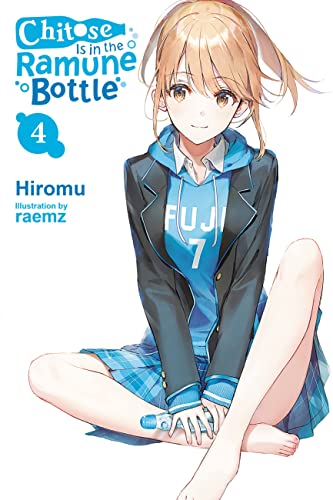By Hiromu and raemz. Released in Japan as “Chitose-kun wa Ramune Bin no Naka” by Gagaga Bunko. Released in North America by Yen On. Translated by Evie Lund.
It was once said, a couple decades ago, that no one would ever license a sports manga because it wouldn’t sell. Nowadays, given the enormous number of people who obsess over series like Haikyu!, that seems a bit ridiculous, but it was true. I’m not entirely sure if there are a large number of unlicensed light novels that follow baseball or basketball teams the way that manga does, but I’m inclined to say probably not. And we certainly don’t have them licensed over here. You’re allowed to dungeon crawl, or try to break off your engagement so you don’t die, but please don’t mention the K word. And by K I mean Koshien. That said, Chitose Is in the Ramune Bottle is notable for having a LOT of jocks in its cast, by the nature of its premise. And it’s this fourth volume that drills right down to the heart of the jock, showing us what it means to dream big, and also balancing the harem again with its shortest member.
We’ve known since the start of the series that Chitose used to play baseball but quit. Now the team is back, begging him to come back as their star is injured, and won’t be ready in time for the first knockout game. Chitose, needless to say, is rather pissed off about this, as he had reasons for leaving the team – which, you’ll be grateful to hear, we finally hear about. He’s also dealing with the girls’ basketball team, which has a new captain, Haru, who’s a taskmaster and is pushing the others past their limits – which they hate. It’s needed in order to make them a better team, but it also makes Haru a very convenient target. Will Chitose manage to help Haru to reconcile things with her basketball team, and can he do that by giving in and playing his last ever baseball game? Even if it means breaking himself to do it.
The series’ best feature remains its ability to convince you, in each new volume, that the girl being focused on is definitely the one who should “win” the Chitose romantic partner sweepstakes. Last volume I said that Asuka was written out in the third book as she was so far ahead of the others. (As it turns out, she’s still around, though Chitose is mooning over her less.) In this volume, it feels like he and Haru also really belong together – they’re birds of a feather, basically, and a reminder that “opposites attract” is not always true. The book is also very good at showing the frustrations of the high school athlete. Haru is a fantastic basketball player. But she’s 4’9″, and there’s simply no way to make up that difference in height in a sport like that. As for Chitose, well, he’s cool. The best scene may have been when he’s wavering back and forth on what to do, and when he tries to do an uncool option Haru chimes in “I don’t like this Chitose.” It was adorable.
So yes, the light novel for normies remains excellent. We’ll see what the next volume brings – Yuuko is on the cover, will she be the lead girl?



